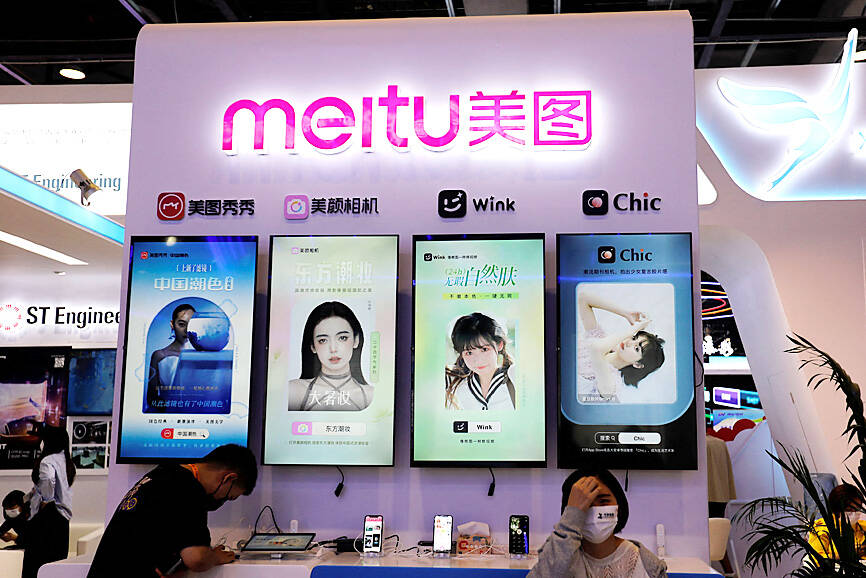The ability to turn a user’s selfie into an anime character has turbocharged an app developed by Meitu Inc (美圖) to the top of Japan’s download rankings over the past week, spurring a big jump in the Hong Kong-based firm’s shares.
Meitu is up more than 50 percent over the past couple of weeks, as its app reached the top of Apple Inc’s free iPhone downloads chart and No. 2 on Android’s Google Play in Japan, data.ai figures showed.
While not new to the Japanese market, the key novelty in the beauty app was the addition of the option to transform a photograph into an anime-style picture with the help of artificial intelligence (AI).

Photo: EPA-EFE
Meitu has been working on AI photo tools since 2017, and its work has begun to pay off with the anime-style selfies, which hit the market in China on Nov. 24 and globally three days later, Meitu CEO Wu Xinhong (吳欣鴻) said.
Since last week, the Meitu app has been among the top three most downloaded on Apple’s App Store in countries including the US, Brazil, Canada, Australia and New Zealand, Wu said.
Global downloads surged 79 percent in the week commencing Nov. 28, data.ai figures showed.

Photo: REUTERS
“We are seeing an explosion of AI-generated content and its huge potential,” Wu said. “It’s an unprecedented opportunity for us, a technological revolution.”
The use of AI to generate images has taken off in popularity this year with the launch of text-to-image systems such as Midjourney and OpenAI’s Dall-E. The technology is not without its controversy, but its appeal and accessibility have helped it proliferate.
Meitu’s approach differs, in applying a style transfer onto an existing image. The company also just introduced the option to add subtle animations — such as falling cherry blossom leaves — to its AI-generated anime avatars.
Japan has proven an eager adopter of this new trend.
University of Tokyo professor Fujio Toriumi said that 40 percent of hashtagged AI-generated images on Twitter since June have come from the country.
Torumi, whose work includes studying information-sharing on Twitter following the 2011 Tohoku earthquake and tsunami, collaborated with the Nikkei Inc to analyze the data.
“Japan has a culture of sharing manga on Twitter,” Toriumi said, adding that the novelty of using AI to generate similar pictures is “both a threat and a surprise” to that established audience, but many are embracing it out of curiosity.
“For most people, it’s a one-shot, but I think some will continue using it in unique ways,” Toriumi said.
At its peak, the AI art fascination was generating close to 80,000 Twitter posts per day out of Japan, although the current flow is about one-third of that, Toriumi said.
Still, he anticipates more new uses in the future, including AI-generated fashion models for clothes companies selling gear online.

IN THE AIR: While most companies said they were committed to North American operations, some added that production and costs would depend on the outcome of a US trade probe Leading local contract electronics makers Wistron Corp (緯創), Quanta Computer Inc (廣達), Inventec Corp (英業達) and Compal Electronics Inc (仁寶) are to maintain their North American expansion plans, despite Washington’s 20 percent tariff on Taiwanese goods. Wistron said it has long maintained a presence in the US, while distributing production across Taiwan, North America, Southeast Asia and Europe. The company is in talks with customers to align capacity with their site preferences, a company official told the Taipei Times by telephone on Friday. The company is still in talks with clients over who would bear the tariff costs, with the outcome pending further

WEAKER ACTIVITY: The sharpest deterioration was seen in the electronics and optical components sector, with the production index falling 13.2 points to 44.5 Taiwan’s manufacturing sector last month contracted for a second consecutive month, with the purchasing managers’ index (PMI) slipping to 48, reflecting ongoing caution over trade uncertainties, the Chung-Hua Institution for Economic Research (CIER, 中華經濟研究院) said yesterday. The decline reflects growing caution among companies amid uncertainty surrounding US tariffs, semiconductor duties and automotive import levies, and it is also likely linked to fading front-loading activity, CIER president Lien Hsien-ming (連賢明) said. “Some clients have started shifting orders to Southeast Asian countries where tariff regimes are already clear,” Lien told a news conference. Firms across the supply chain are also lowering stock levels to mitigate

NEGOTIATIONS: Semiconductors play an outsized role in Taiwan’s industrial and economic development and are a major driver of the Taiwan-US trade imbalance With US President Donald Trump threatening to impose tariffs on semiconductors, Taiwan is expected to face a significant challenge, as information and communications technology (ICT) products account for more than 70 percent of its exports to the US, Chung-Hua Institution for Economic Research (CIER, 中華經濟研究院) president Lien Hsien-ming (連賢明) said on Friday. Compared with other countries, semiconductors play a disproportionately large role in Taiwan’s industrial and economic development, Lien said. As the sixth-largest contributor to the US trade deficit, Taiwan recorded a US$73.9 billion trade surplus with the US last year — up from US$47.8 billion in 2023 — driven by strong

RESHAPING COMMERCE: Major industrialized economies accepted 15 percent duties on their products, while charges on items from Mexico, Canada and China are even bigger US President Donald Trump has unveiled a slew of new tariffs that boosted the average US rate on goods from across the world, forging ahead with his turbulent effort to reshape international commerce. The baseline rates for many trading partners remain unchanged at 10 percent from the duties Trump imposed in April, easing the worst fears of investors after the president had previously said they could double. Yet his move to raise tariffs on some Canadian goods to 35 percent threatens to inject fresh tensions into an already strained relationship, while nations such as Switzerland and New Zealand also saw increased